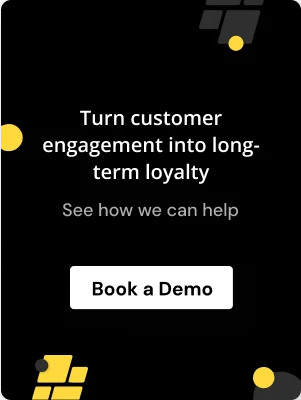.avif)
.avif)
Customer retention is one of the most powerful drivers of business growth. In fact, increasing retention rates by only 5% can lead to a 25% to 95% increase in profits. Retaining customers goes far beyond keeping them around. You have to build strong, ongoing relationships that lead to repeat business.
Advanced technologies like AI, CRM systems, and predictive analytics help businesses enhance these relationships by personalizing experiences, automating processes, and gaining real-time insights. In this blog, we’ll explore everything you must know about incentive programs to help with not only boosting engagement but also cultivating long-term loyalty for your brand.
At a Glance:
- Keeping existing customers is more affordable than acquiring new ones and has a significant influence on sustained revenue growth.
- Advanced technologies like AI, CRM, and predictive analytics help businesses personalize customer experiences and optimize retention strategies.
- Automation streamlines customer interactions, reduces manual work, and ensures timely, relevant communication, improving customer satisfaction.
- Loyalty programs drive repeat purchases and motivate customers to refer others, deepening brand loyalty and increasing lifetime value.
- Real-time data insights enable businesses to quickly adjust retention strategies, ensuring they stay relevant and effective.
How Do Advanced Technologies Boost Customer Retention?
Retaining customers is much more cost-efficient than the continuous effort of attracting new ones. Advanced technologies like CRM systems, AI, machine learning, and data analytics are reshaping how businesses engage and retain customers. By enhancing personalization and automating processes, these tools make loyalty more attainable and impactful.
- Why Retaining Customers Is Crucial: It’s five times more expensive to attract new customers than to keep existing ones. Retention saves money while building brand loyalty.
- How Repeat Customers Impact Revenue: Repeat customers drive consistent revenue and higher lifetime value. In fact, the probability of selling to an existing customer is 60-70%. Their loyalty leads to more frequent purchases and valuable referrals, making them an essential part of sustainable business growth.
- Technologies Enabling Customer Retention: CRM systems track data, AI personalizes experiences, and analytics help businesses make real-time improvements to boost engagement and loyalty.
Why is Integrating Advanced Technologies into Retention Strategies Crucial?
Integrating advanced technologies into customer retention strategies enhances the customer experience. It also streamlines operations for increased efficiency. These tools optimize personalization, automate processes, and provide real-time data, making retention strategies more responsive and effective.

1. Personalized Marketing
Advanced technologies allow businesses to create highly targeted marketing campaigns tailored to customer behavior and preferences. For example, an e-commerce store might use machine learning to analyze customers' past purchases and recommend products they’re likely to be interested in, driving repeat purchases.
Besides, personalized offers, such as discounts on frequently bought items or new arrivals in their preferred category, make customers feel valued and increase their likelihood of returning.
2. Operational Efficiency
Automation handles repetitive tasks efficiently, freeing up resources for more valuable customer interactions. For example, businesses can automate the process of sending reminders about unused loyalty points. They can also schedule personalized discount offers for customers based on their shopping history.
This not only enhances operational efficiency but also improves customer engagement without increasing manual work.
Also Read: 9 Successful Loyalty Program Examples to learn from in 2025
3. Real-Time Insights & Analytics
With real-time analytics, businesses can track customer behavior and make timely decisions. For example, suppose a product is frequently added to carts but not purchased. In that case, businesses can identify this trend in real time and offer a special discount or incentive to encourage purchase completion.
Real-time data also enables businesses to adjust marketing strategies on the fly, ensuring they stay relevant and keep customers engaged.
4. Enhanced Customer Engagement
AI-driven tools and automated systems help businesses create meaningful interactions with customers. For example, a business might use a recommendation engine that suggests products based on the customer’s previous interactions. This helps in keeping them engaged with relevant content.
Similarly, automated customer service bots can handle queries instantly, offering personalized solutions that keep customers satisfied and more likely to return. These types of proactive, personalized engagements ensure customers feel heard and valued.
What Are the Main Technologies Driving Customer Retention?
Key technologies like AI, CRM systems, and predictive analytics increasingly shape customer retention. These tools enable businesses to automate processes, personalize experiences, and anticipate customer needs, ultimately improving long-term engagement and loyalty.
1. Automation and AI in Customer Service
Automation and AI in customer service involve using technologies like AI-powered chatbots, virtual assistants, and automated ticketing systems to streamline customer support. These tools allow businesses to address common customer queries without manual intervention, providing fast, effective solutions.
Why It’s Helpful:
- Utilizing AI for Instant Support: AI-powered chatbots can handle routine customer queries instantly, reducing wait times and freeing up human agents to focus on complex issues. This leads to faster resolutions and a more satisfying support experience.
- Efficient Task Automation: Automating repetitive tasks allows customer service teams to focus on more complex issues. This not only boosts overall productivity but also improves the quality of customer interactions.
- Providing 24/7 Assistance: Chatbots and virtual assistants can provide uninterrupted support, making sure that customers always have access to help, no matter the time of day.
- Cost Reduction: AI helps businesses reduce customer service costs by decreasing the need for a large support team. This can allow companies to reallocate resources toward improving other areas of the business.
2. Using Predictive Analytics to Anticipate Customer Behavior
Predictive analytics utilizes customer data, machine learning models, and historical trends to forecast future actions, preferences, and behavior. It helps businesses anticipate customer needs, personalize marketing, and make data-driven decisions ahead of time.
Why It’s Helpful:
- Using AI to Predict Needs: By analyzing historical purchase data and customer actions, Predictive analytics can anticipate a customer's next need. For instance, it can suggest products a customer may be interested in. This ultimately increases the likelihood of a purchase.
- Targeting the Right Customers: Businesses can identify high-value customers through predictive models. This helps businesses target the most promising customers, boosting the ROI on marketing efforts.
- Improved Decision-Making: Predictive tools help businesses adjust marketing strategies and product offerings based on upcoming trends and customer preferences, ensuring that decisions are data-driven and timely.
- Increasing Retention: By predicting customer churn, businesses can also proactively offer incentives or reminders that reduce the likelihood of customers leaving, ultimately increasing long-term customer retention.
3. Loyalty Program
Loyalty programs are strategies designed to reward customers for their repeat business, such as making purchases or referring others. These programs build stronger, long-term relationships by offering incentives like points, discounts, and special offers, which encourage consistent customer engagement.
Why It’s Helpful:
- Drives Repeat Purchases: By rewarding customers for returning, loyalty programs incentivize them to make more frequent purchases, directly boosting sales. 61% of customers say rewards programs are key to their decision to give a company repeat business, making them an essential driver of long-term engagement
- Increases Customer Lifetime Value (CLV): Customers who participate in loyalty programs engage with your brand over time, increasing their overall value.
- Strengthens Emotional Bonds: Customers who feel appreciated can emotionally connect with your brand, transforming them from one-time buyers to loyal advocates.
- Encourages Referrals & Word-of-Mouth Marketing: Satisfied, loyal customers will refer your brand to others. This helps in expanding your customer base and driving growth.
However, building a loyalty program that keeps customers hooked to your site is extremely important. With Nector, you can do it easily. Nector automates and customizes loyalty programs, integrating seamlessly with e-commerce platforms like Shopify. Nector uses gamification, incorporating game-like elements such as points, badges, and leaderboards to enhance customer experience and boost engagement. This approach encourages repeat interactions, turning everyday activities into rewarding experiences that keep customers coming back.
4. Personalization and Engagement Tools
Personalization and engagement tools include technologies such as AI, machine learning, and IoT that deliver customized experiences based on user behavior. These tools allow businesses to craft personalized content, offers, and communication tailored to individual customer preferences.
Why It’s Helpful:
- Utilizing AI for Personalized Recommendations: AI-driven algorithms analyze user behavior to recommend relevant products, content, or offers. This boosts engagement by providing customers with exactly what they want, increasing the chances of conversion.
- Crafting Unique Experiences: Personalized emails, thoughtful promotions, and tailored web pages deepen the connection between a brand and its people. When someone receives product suggestions based on what they’ve bought before, it tells them, we remember you, and that builds trust.
- Maximizing Engagement Through Relevant Content: By using AI to create targeted messages based on a customer's browsing history and preferences, businesses can keep customers engaged longer. This reduces bounce rates and drives more interactions.
- Building Loyalty Through Tailored Offers: Personalized experiences show customers that their preferences matter, fostering loyalty. Businesses can adjust reward systems based on individual behaviors, ensuring that each customer’s journey feels personal and rewarding.
5. Fraud Prevention and Data Security: Protecting Your Retention Efforts
Fraud prevention and data security technologies protect sensitive customer data by identifying suspicious activities. This way, businesses can ensure secure transactions and comply with privacy regulations. Technologies such as AI, blockchain, and encrypted communications are used to safeguard data from breaches and fraud.
Why It’s Helpful:
- Utilizing AI for Real-Time Fraud Detection: AI-driven systems continuously monitor transactions for unusual behavior or patterns. By instantly identifying fraudulent activity, businesses can block malicious transactions and prevent losses, protecting both the company and customers.
- Securing Data with Encryption: Using robust encryption protocols ensures that customer data remains safe during transactions. This instills trust in customers, knowing that their personal and financial information is protected.
- Building Customer Trust with Transparency: Clearly communicating how customer data is protected builds confidence in the brand. Customers' chances to engage and make repeat purchases are more when they know their information is secure.
- Meeting Compliance Standards: Using fraud prevention technologies ensures businesses comply with privacy laws, including GDPR and CCPA. This avoids penalties and fosters trust by adhering to regulations designed to protect customer data.
How to Evaluate the Effectiveness of Retention Strategies?
Data-driven insights back effective retention strategies. By monitoring key metrics and real-time analytics, businesses can continuously refine their approach, ensuring sustained customer loyalty and improved lifetime value.
Key Metrics for Retention Success
To assess retention effectiveness, track metrics like Customer Lifetime Value (CLV), redemption rates, and customer engagement. CLV gauges long-term revenue potential, while redemption rates measure program effectiveness. Customer engagement reflects ongoing interactions, indicating a strong emotional connection and brand loyalty.
Real-Time Analytics for Ongoing Improvement
Staying in tune with customers means more than checking a dashboard every quarter. Real-time analytics give you a window into what’s happening right now.
When someone clicks, ignores, redeems, or bounces, you can see it. And more importantly, you can act on it. This lets businesses:
- Shift loyalty rewards based on what’s trending in the moment
- Spot patterns early, before a customer goes quiet for good
- Test and adjust email timing, messages, and offers on the fly
- Tailor experiences as customers move through different life stages or buying habits
It turns static programs into living, breathing systems—ready to meet people where they are, every step of the way. The faster you notice the shift, the faster you can respond, and the longer you can keep them with you.
Also Read: A Practical Guide to Effective Customer Retention Management
Overcoming Common Challenges in Customer Retention
Retention challenges usually don’t come from a single issue, they build over time through small inefficiencies, missed signals, or poorly connected systems. While tools can support the process, they’re only as useful as the clarity behind their use. Below is a breakdown of common problems, along with focused strategies that actually shift outcomes.
1. Customer Churn
Churn is rarely abrupt. Customers often disengage in stages—slower browsing, skipped emails, smaller purchases—until they disappear entirely. The difficulty lies in spotting these early indicators before the relationship fades out completely.
Addressing this starts with behavioral tracking. Declines in frequency, average order value, or engagement rates should trigger internal alerts. From there, outreach needs to reflect specific user history, not broad incentives, but timely, relevant nudges. Think in terms of pattern disruption. A lapse in activity should not go unanswered, especially if the customer once showed strong interest. Consistency here builds retention discipline across teams.
2. Data Silos
When different departments rely on disconnected systems, customers end up being treated like strangers with each interaction. A support team may not know a shopper is VIP. A marketing team may send emails that contradict recent behavior. Fragmentation at this level undermines retention efforts at every step.
Combining purchase data, communication history, support interactions, and site behavior into a single profile makes every action more precise. It doesn’t require a perfect system, just enough cross-functional visibility to inform decisions. Even partial integration between key platforms (CRM, email marketing, analytics) can drastically reduce redundancies and make personalization viable.
3. Impersonal Messaging
Mass communication is easier to send but far easier to ignore. Generic emails and promotions don’t account for what a customer actually cares about, and they train people to filter you out. The more irrelevant the message, the weaker the relationship.
Retention improves when content reflects real behavior. Segments based on buying habits, timing preferences, and past responses yield better outcomes than demographic assumptions alone. The goal is to speak to intent, not just identity. A reminder about a replenishable item, a price drop on a viewed product, or a message that references previous support, all of these create relevance without overengineering.
4. Inconsistent Engagement
Irregular outreach creates distance. Even loyal customers are quick to forget when a brand fades from view. Sporadic communication also leaves businesses reacting too late, after attention has already shifted elsewhere.
A steady cadence, even if minimal, builds familiarity. Lifecycle campaigns tied to onboarding, product use, or seasonal relevance give structure without overwhelming the recipient. Pairing reactive systems (e.g., triggered messages) with planned content schedules ensures coverage during both active and dormant periods. Balance is more important than frequency.
5. Poor Tool Integration
Retention tools often fail not because they’re ineffective, but because they aren’t fully embedded into daily operations. Teams juggle multiple logins, transfer data manually, and work around limitations instead of within a system that fits.
Smooth integration depends less on the size of the platform and more on how well it communicates with what’s already in place. Choosing systems that share data openly, offer consistent support, and don’t require extensive custom work will reduce friction over time. Setup is only the first step, long-term usefulness depends on how easily staff can act on the insights those tools provide.
The strength of a retention strategy lies in its systems, not just the tools, but how they’re connected, maintained, and understood. When teams share information, messages match user behavior, and timing feels intentional, retention becomes a byproduct of consistency rather than guesswork.
For teams looking to simplify this process without compromising depth, a solution built for clarity and connection makes all the difference.
.avif)
Boost Smarter Customer Retention with Nector
Want to make customer retention effortless? Nector helps you build and automate loyalty programs directly within your e-commerce setup, no heavy lifting required. It integrates with platforms like Shopify, WooCommerce, and even custom-built sites, letting you sync customer data and launch a rewards program in minutes.
Beyond e-commerce platforms, Nector connects with over 50 tools, including Klaviyo, JudgeMe, and GoKwik, so you can automate workflows, personalize communication, and reward your customers at every step, from purchases and reviews to referrals and more. Whether your goal is to grow your customer base or keep existing ones coming back, Nector helps turn retention into a system that works in the background, consistently and at scale.
Ready to make customer retention work for you? Let’s make it happen with Nector. Sign up now.
Wrapping Up
Technology is the key to boosting customer retention. With tools like AI, predictive analytics, and CRM systems, businesses can create personalized, data-driven experiences that build loyalty. These technologies allow businesses to track customer behavior, offer timely promotions, and streamline engagement.
As customer needs evolve, continuous innovation is extremely important. By utilizing real-time data, businesses can stay agile and ensure their retention strategies remain relevant.
Nector’s seamless integration and powerful loyalty solutions help businesses automate and optimize their retention programs. It conveniently assists businesses in building long-lasting customer loyalty while staying ahead of the curve. Book a Demo with us and learn how to create the best loyalty program for your customers today!
FAQs
How can technology be used for customer retention?
Technology improves customer retention by personalizing experiences, automating loyalty programs, and tracking customer behavior in real time. Tools like CRMs, AI, and analytics help businesses engage customers consistently and reduce churn.
Which tactic is used to improve customer retention?
Personalized communication and loyalty programs are among the most effective tactics. Using customer data to tailor offers and messages builds stronger relationships and keeps customers coming back.
What role does technology play in enhancing customer loyalty?
Technology supports loyalty by automating rewards, analyzing customer behavior, and sending personalized offers. This makes customers feel valued and encourages repeat purchases.
How do you maximize customer health and retention through customer success platform technology?
Customer success platforms track engagement, monitor health scores, and automate outreach. They help identify issues early and keep customers satisfied, reducing the risk of churn.
Can automation boost customer retention?
Yes, automation boosts retention by sending timely, personalized messages based on customer behavior. It helps businesses stay connected without manual effort and improves long-term loyalty.
Start Building Customer Retention That Lasts





.avif)
.avif)
%201.webp)

